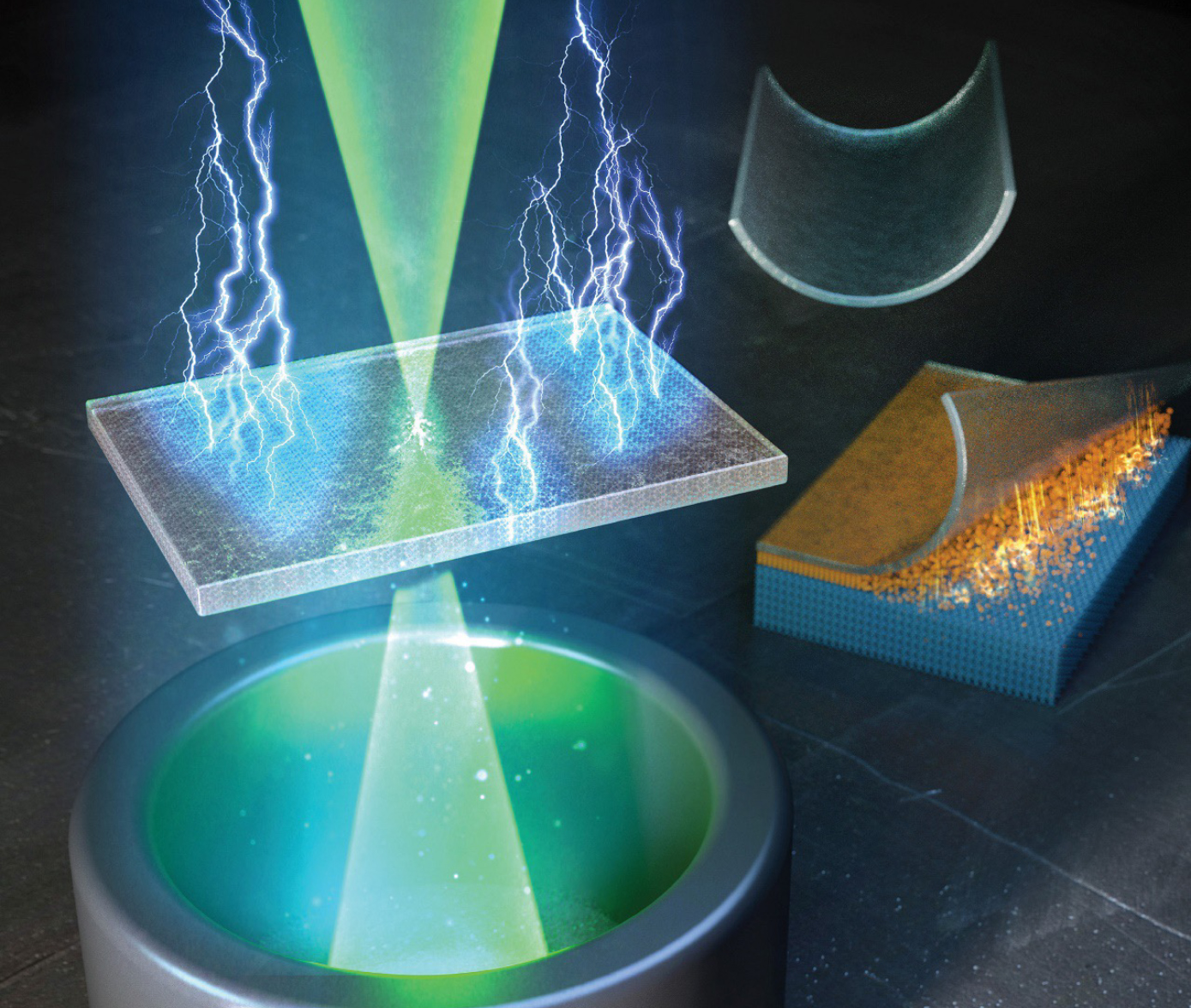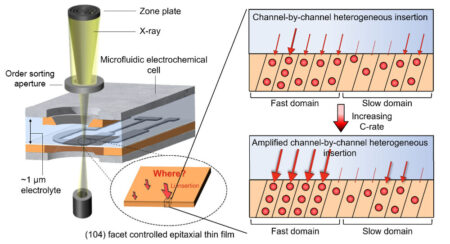SCIENTIFIC ACHIEVEMENT
By using the Advanced Light Source (ALS) to directly visualize the uneven insertion of lithium ions into electrodes with well-defined crystal orientations, researchers learned why fast charging decreases battery lifespan and performance.
SIGNIFICANCE AND IMPACT
The work could provide insights into better battery utilization and help investigations of the surface insertion reaction during fast charging.

Life in the slow lane
The rapid charging of lithium-ion batteries leads to significant performance degradation over time. In electric vehicles, this manifests as a shorter driving range per charge. To mitigate this, slow charging is often recommended, despite the fact that rapid charging is essential for the widespread adoption of environmentally friendly electric vehicles.
A key factor influencing this performance degradation is the uniformity of the lithium flow into and out of battery electrodes during charging and discharging. Nonuniform insertion leads to localized expansion of the lattice structure, causing local strain and stress that exacerbates degradation. A better understanding of this unevenness will help scientists design better batteries that last longer and charge faster.
However, the spatial heterogeneity of lithium insertion is challenging to study because of the complexity of the materials (layered oxides) and generally poorly defined interfaces. In this study, researchers developed a model system that allowed them to decouple competing effects and watch, in real-time, how and where batteries charge at the nanoscale.
Channeling the lithium
Lithium insertion involves two distinct processes: the surface charge-transfer reaction and diffusion into the bulk. In conventional samples, these processes are convoluted, making it difficult to isolate their contributions to overall insertion heterogeneity. In this work, the researchers developed a nanobattery system that drastically reduces the bulk diffusion effects.
The layered oxide, LiNi1/3Mn1/3Co1/3O2 (NMC111), is a common cathode material that can host lithium ions in channels between its layers, and the lithium diffusion barrier between layers is significantly higher than within a channel. Capitalizing on this, the team epitaxially fabricated a single-crystal NMC111 thin film such that its lithium channels would be oriented parallel to the x-ray probe. This enabled the researchers to use scanning transmission x-ray microscopy (STXM) to measure lithium content and insertion rate while minimizing the complicating factor of bulk diffusion.

COSMIC operando electrochemistry
At ALS Beamline 7.0.1.2 (COSMIC Imaging), the researchers used operando STXM to spatially resolve the lithium insertion process at different charging rates—the first operando electrochemistry measurement to be published based on COSMIC data. Notably, the beamline’s fast scan speed makes it uniquely suited for investigating heterogeneity under fast-charging conditions (under 10 minutes). The beamline’s high spatial resolution enabled the acquisition of lithium concentration at each pixel, allowing the detection of even subtle state-of-charge variations. This level of precision is expected to prove valuable in future studies of systems exhibiting even lower degrees of heterogeneity.
The data unambiguously revealed that the heterogeneous evolution of lithium concentration is due to variations in channel-by-channel insertion rates, and that increasing the lithium-ion current density (i.e., charging rate) exacerbated this heterogeneity. In the future, COSMIC’s ptychography capabilities are expected to offer the unique opportunity to observe and investigate heterogeneity on the order of 10 nm—a scale that was recently demonstrated by this research team under specific charge/discharge conditions but is inaccessible to conventional STXM. In general, the development of a single-crystalline thin-film nanobattery coupled with microscopy opens up the possibility of new fundamental knowledge that could potentially guide the design of layered oxide cathode materials for improved rate capability and cycle stability.

Contact: Jongwoo Lim
Researchers: J. Chung, C. Nam, J.Y. Kim, T.H. Lee, J. Kim, D. Lee, B. Koo, S. Jo, J. Cho, S. Kunze, Y.S. Choi, J. Song, H. Choi, J. Kim, S.H. Park, H. Lee, H.W. Jang, and J. Lim (Seoul National University, Republic of Korea); B.H. Hong (Seoul National University, Republic of Korea, and Advanced Institute of Convergence Technology, Republic of Korea); N. Kim (Pohang Accelerator Laboratory); and D.A. Shapiro (ALS).
Funding: National Research Foundation of Korea, Ministry of Small and Medium-sized Enterprises and Startups of Korea, and LG Energy Solution. Operation of the ALS is supported by the US Department of Energy, Office of Science, Basic Energy Sciences program.
Publication: J. Chung, C. Nam, J.Y. Kim, T.H. Lee, J. Kim, D. Lee, B. Koo, S. Jo, J. Cho, S. Kunze, Y.S. Choi, J. Song, H. Choi, J. Kim, S.H. Park, H. Lee, B.H. Hong, N. Kim, D.A. Shapiro, H.W. Jang, and J. Lim, “Elucidating Heterogeneous Li Insertion Using Single-Crystalline and Freestanding Layered Oxide Thin Film,” Nano Lett. 24, 14766 (2024), doi:10.1021/acs.nanolett.4c04129.
ALS SCIENCE HIGHLIGHT #518